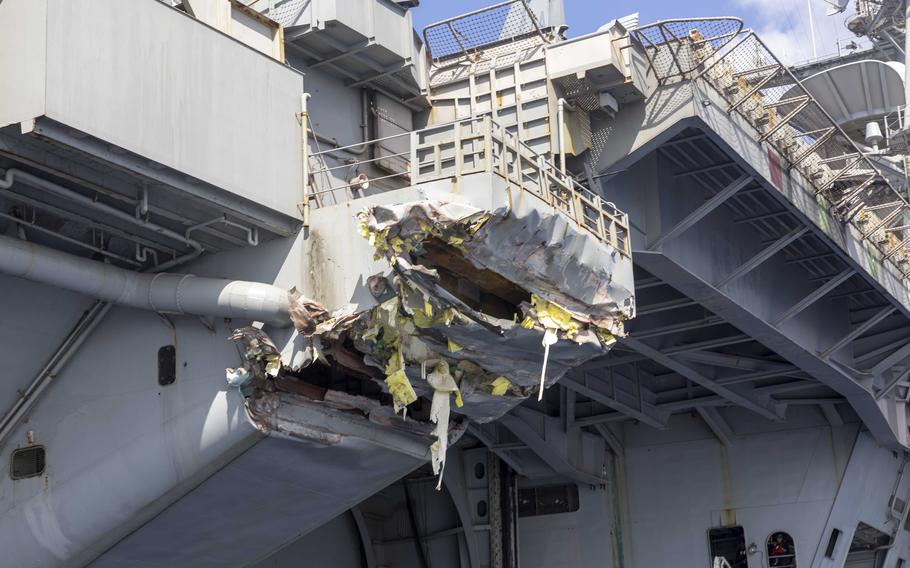
Damage to the USS Harry S. Truman as viewed from a rigid-hull inflatable boat on Feb. 13, 2025. The aircraft carrier was involved in a collision with the cargo vessel Besiktas-M a day earlier while operating in the vicinity of Port Said, Egypt. (Cody Beam/U.S. Navy)
NAPLES, Italy — The aircraft carrier USS Harry S. Truman remains in the eastern Mediterranean Sea as its crew assesses damage from a late-night collision this week with a cargo ship near the Suez Canal.
The full extent of the damage wasn’t clear Friday. An initial assessment indicated damage from the collision Wednesday near Port Said, Egypt, was above the water line and not near the flight deck, U.S. 6th Fleet told Stars and Stripes on Friday.
On Friday afternoon, the Navy released a photo of Truman showing damage to a deck area on the starboard quarter side of the ship, or back right end. The area is located just behind one of the carrier’s aircraft elevators, which was not damaged, 6th Fleet said.
There were no injuries or flooding, and the ship’s propulsion plants were unaffected, the command said in an earlier statement.
Crew members were assessing exterior and interior impacts, which will be reported to the command to determine next steps, 6th Fleet said.
The collision with the Panama-flagged bulk cargo carrier Besiktas-M, occurred at 11:46 p.m. local time as Truman was transiting the congested area near the Suez Canal, presumably waiting to head south into the Red Sea.
Truman’s escort, the destroyer USS Jason Dunham, was nearby but not involved in the collision. Dunham also remains in the Mediterranean, 6th Fleet said.
On Thursday, Besiktas-M had left the area and was headed to Romania, Sal Mercogliano, an adjunct professor at the U.S. Merchant Marine Academy and shipping expert, said in a video posted to his YouTube account the same day.
The collision happened as Besiktas-M was traveling northwest out of the canal in an area, known as an anchorage, congested with tankers and cargo ships, said Mercogliano, citing data from marinetraffic.com.
Truman and Dunham weren’t transmitting their location data at the time of the collision, “even though they are supposed to be using it while they are in traffic,” said Mercogliano, who noted that Besiktas-M was transmitting its position.
Cmdr. Timothy Gorman, a 6th Fleet spokesman, declined to discuss whether the U.S. ships’ positioning indicators, known as AIS, were turned off, saying it was too early in the investigation to comment about the circumstances of the collision.
In a Thursday appearance on the news program LiveNOW Fox, Mercogliano described damage to Besiktas-M as minimal and located on the ship’s starboard bow, or front right side.
The minor impact to the cargo ship was a good sign but questions remained about the extent of damage to Truman, potentially to its hull and deck overhangs, he said.
Truman was in the eastern Mediterranean after leaving Naval Support Activity Souda Bay on the Greek island of Crete on Tuesday. The ship, along with embarked Carrier Air Wing 1 and Dunham, arrived at Souda Bay on Feb. 6 for a “working port visit” for maintenance while allowing sailors a break.
The port call came after Truman spent about two months on duty in the Red Sea supporting strikes against the Houthis in Yemen, among other assignments.
The Navy has kept a nearly constant carrier strike group presence in the Middle East since November 2023 in the aftermath of Hamas’ deadly attack on Israel on Oct. 7 of the same year. Houthi militants began their campaign against ships in the Red Sea weeks afterward.
The aircraft carrier USS Dwight D. Eisenhower spent nearly seven months in and around the Red Sea defending against Houthi attacks, returning to the U.S. in July after a historic nine-month deployment.
The aircraft carriers USS Theodore Roosevelt and USS Abraham Lincoln also have been on duty in the region for shorter time spans.
The Eisenhower Carrier Strike Group and the Truman group “have operated in the most intense period of sustained combat activity for the U.S. Navy since World War II,” the service said.